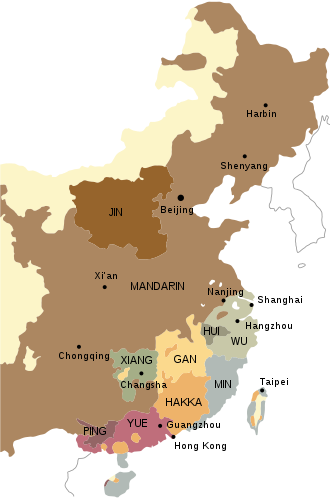Varieties of Chinese
Chinese is a branch of the Sino-Tibetan language family. It has hundreds of local languages, many of which are not mutually understandable. There is more variation in the mountainous southeast. There are seven main groups: Mandarin, Wu, Min, Xiang, Gan, Hakka and Yue.
| Chinese | |
|---|---|
| Sinitic | |
| Ethnicity: | Han Chinese |
| Geographic distribution: | Mainland China, Hong Kong, Macau, Taiwan, Southeast Asia and other regions with historic immigration from China |
| Linguistic classification: | Sino-Tibetan
|
| Subdivisions: | |
| ISO 639-5: | zhx |
 Primary branches of Chinese according to the Language Atlas of China | |
Chinese varieties differ most in their phonology (sounds) but have similar vocabulary and syntax (grammar). Southern varieties tend to have fewer initial consonants but more often preserve the Middle Chinese final consonants. All have tones. Northern varieties have fewer tones. Many have tone sandhi (biandao). Zhejiang coast and eastern Guangdong has some of the most complex patterns.
Standard Chinese is based on the Beijing dialect. Its vocabulary is based on Mandarin group and grammar based on literature in the modern written vernacular. It is the official language of China, one of the four official languages of Singapore, and one of the six official languages of the United Nations.
History
In the 2nd millennium BC, a form of Chinese was spoken in around the Huanghe. It then expanded east across the North China Plain to Shandong and then south towards the Yangzi river valley. It replaced former languages in the south.
During times of unity, people wanted to use a common standard language to make communication easier between people.[1]
Evidence for dialectal variation is found in texts from the Spring and Autumn period (722–479 BC). At that time, the Zhou still defined a standard speech.[2] The Fangyan (1st century CE) studies the differences in vocabulary between regions.[3] Texts from the Eastern Han period also discuss local differences in pronunciation. The Qieyun rhyme book (601) noted wide variation in pronunciation between regions. It wanted to define a standard pronunciation for reading the classics.[4] This standard is called Middle Chinese.[5]
The North China Plain was flat and easy to move around. So people in the north pretty much spoke the same language.
But South China had many mountains and rivers. So it had six major groups of Chinese languages, with great internal diversity, particularly in Fujian.[6][7]
Modern Standard Chinese
Until the mid-20th century, most Chinese people spoke only their local language. But the Ming and Qing dynasties defined a common language based on Mandarin. It was known as Guānhuà (官話, "speech of officials"). Knowledge of guanhua was essential for a career as a government official.[8]
Until the 20th century, Classical Chinese was the written standard.
The Republic of China replaced as the written standard by written vernacular Chinese, which was based on northern dialects. In the 1930s a standard national language was adopted, with its pronunciation based on the Beijing dialect, but with vocabulary also drawn from other Mandarin varieties.[9] It is the official spoken language of the People's Republic of China.
Standard Mandarin Chinese now dominates public life.[10] The only other Chinese that may be commonly taught in colleges is Cantonese.[11]
The different Chinese languages
- Mandarin 管
-
- Spoken in northern and southwestern China
- Has the most speakers
- Includes the Beijing dialect, the basis for Standard Chinese
- Includes the Dungan language of Kyrgyzstan and Kazakhstan (written in Cyrillic script).
- Wu 吴
-
- Spoken in Shanghai, most of Zhejiang and the southern parts of Jiangsu and Anhui.
- Hundreds of different spoken forms, many of which are not mutually intelligible.[13]
- Uses stops, affricates and fricatives[14]
- Xiang 湘
- Min 闽
-
- Spoken in Fujian and eastern Guangdong
- Most conservative language and closest to Middle Chinese
- Most diverse[18]
- Varieties from the coast of Fujian around Xiamen have spread to Southeast Asia (where it is called Hokkien) and Taiwan (where it is called Taiwanese Hokkien).[19]
- Also spoken in Hainan, Leizhou Peninsula, and throughout southern China.[20]
- Hakka 客家
- Yue
-
- Spoken in Guangdong, Guangxi, Hong Kong and Macau
- Common among migrants to Southeast Asia and many other parts of the world.
- The prestige variety and by far most commonly spoken variety is Cantonese from the city of Guangzhou (historically called "Canton")
- Cantonese is also the native language of the majority in Hong Kong and Macau.[23]
- Use the same endings as Hakka (/p/, /t/, /k/, /m/, /n/ and /ŋ/)
- Many tones (typically 6 - 9)[22]
Relationships between groups
The different Chinese varieties are sometimes divided into three groups: Northern (Mandarin), Central (Wu, Gan, and Xiang) and Southern (Hakka, Yue, and Min).
The Southern Group may come from the Yangzi River during the Han dynasty (206 BC – 220 AD). This is sometimes called the Old Southern Chinese.
The Central group was transitional between the Northern and Southern groups.[24]
Varieties Of Chinese Media
Extent of the palatal merger in the core Chinese-speaking area[25]
Distribution of stop codas[26]
Variation in the number of tone categories[27]
Variation in the placement of animal gender markers[28]
Distribution of attributive markers:[29]* cognate of 的 Template:Tlit* classifier
Distribution of copulas:[30]* cognate of 是 Template:Tlit* cognate of 係 Template:Tlit
Distribution of comparative constructions:[31]* phrase before verb* phrase after verb* adverbial or no marker
A school in Guangdong with writing "Please speak Standard Chinese. Please write standard characters" on the wall.
Citations
- ↑ Norman (1988), pp. 183, 185.
- ↑ Norman (1988), p. 183.
- ↑ Norman (1988), p. 185.
- ↑ Ramsey (1987), pp. 116–117.
- ↑ Norman (1988), pp. 24–25.
- ↑ Norman (1988), pp. 183–190.
- ↑ Ramsey (1987), p. 22.
- ↑ Norman (1988), p. 136.
- ↑ Ramsey (1987), pp. 3–15.
- ↑ Norman (1988), p. 247.
- ↑ Norman (1988), p. 187.
- ↑ Chinese Academy of Social Sciences (2012), pp. 3, 125.
- ↑ Yan (2006), p. 90.
- ↑ Norman (1988), pp. 199–200.
- ↑ Kurpaska (2010), pp. 46, 49–50.
- ↑ Yan (2006), p. 148.
- ↑ Norman (1988), pp. 207–209.
- ↑ Norman (1988), p. 188.
- ↑ Norman (1988), pp. 232–233.
- ↑ Norman (1988), p. 233.
- ↑ Norman (1988), p. 224.
- ↑ 22.0 22.1 Norman (1988), p. 217.
- ↑ Norman (1988), p. 215.
- ↑ Norman (1988), pp. 182–183.
- ↑ Cao (2008a), Map 66.
- ↑ Cao (2008a), Map 124.
- ↑ Cao (2008a), Map 1.
- ↑ Cao (2008c), Map 76.
- ↑ Cao (2008c), Map 41.
- ↑ Cao (2008c), Map 38.
- ↑ Cao (2008c), Map 98.
Works cited
- Beijing University (1989), Hànyǔ fāngyīn zìhuì 汉语方音字汇 [Dictionary of Dialect Pronunciations of Chinese Characters] (2nd ed.), Beijing: Wenzi Gaige Chubanshe, ISBN 978-7-80029-000-8.
- Chen, Ping (1999), Modern Chinese: History and sociolinguistics, New York: Cambridge University Press, ISBN 978-0-521-64572-0.
- Chinese Academy of Social Sciences (2012), Zhōngguó yǔyán dìtú jí (dì 2 bǎn): Hànyǔ fāngyán juǎn 中国语言地图集(第2版):汉语方言卷 [Language Atlas of China (2nd edition): Chinese dialect volume], Beijing: The Commercial Press, ISBN 978-7-100-07054-6.
- DeFrancis, John (1984), The Chinese Language: Fact and Fantasy, Honolulu: University of Hawaii Press, ISBN 978-0-8248-1068-9.
- Hsieh, Hsiu-Mei (2007), Exploring teachers' views about native language instruction and education in Taiwanese elementary schools (PhD thesis), University of Texas at Austin, hdl:2152/3598.
- Iwata, Ray (2010), "Chinese Geolinguistics: History, Current Trend and Theoretical Issues", Dialectologia, Special issue I: 97–121.
- Kurpaska, Maria (2010), Chinese Language(s): A Look Through the Prism of "The Great Dictionary of Modern Chinese Dialects", Walter de Gruyter, ISBN 978-3-11-021914-2.
- Lewis, M. Paul; Simons, Gary F.; Fennig, Charles D., eds. (2015), Ethnologue: Languages of the World (Eighteenth ed.), Dallas, Texas: SIL International.
- Liang, Sihua (2014), Language Attitudes and Identities in Multilingual China: A Linguistic Ethnography, Springer International Publishing, ISBN 978-3-319-12618-0.
- Mair, Victor H. (1991), "What Is a Chinese 'Dialect/Topolect'? Reflections on Some Key Sino-English Linguistic terms" (PDF), Sino-Platonic Papers, 29: 1–31.
- ——— (2013), "The Classification of Sinitic Languages: What Is 'Chinese'?" (PDF), in Cao, Guangshun; Djamouri, Redouane; Chappell, Hilary; Wiebusch, Thekla (eds.), Breaking Down the Barriers: Interdisciplinary Studies in Chinese Linguistics and Beyond, Taipei: Institute of Linguistics, Academia Sinica, pp. 735–754, ISBN 978-986-03-7678-4, archived from the original (PDF) on 16 April 2018, retrieved 15 April 2018.
- Norman, Jerry (1988), Chinese, Cambridge: Cambridge University Press, ISBN 978-0-521-29653-3.
- ——— (2003), "The Chinese dialects: phonology", in Thurgood, Graham; LaPolla, Randy J. (eds.), The Sino-Tibetan languages, Routledge, pp. 72–83, ISBN 978-0-7007-1129-1.
- Ramsey, S. Robert (1987), The Languages of China, Princeton University Press, ISBN 978-0-691-01468-5.
- Tang, Chaoju; Van Heuven, Vincent J. (2007), "Predicting mutual intelligibility in chinese dialects from subjective and objective linguistic similarity" (PDF), Interlingüística, 17: 1019–1028.
- Wang, Feng (2005), "On the genetic position of the Bai language", Cahiers de Linguistique Asie Orientale, 34 (1): 101–127, doi:10.3406/clao.2005.1728.
- Wurm, Stephen Adolphe; Li, Rong; Baumann, Theo; Lee, Mei W. (1987), Language Atlas of China, Longman, ISBN 978-962-359-085-3.
- Yan, Margaret Mian (2006), Introduction to Chinese Dialectology, LINCOM Europa, ISBN 978-3-89586-629-6.









